City Information
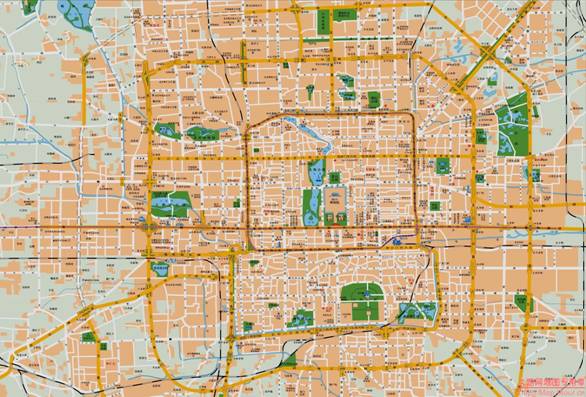
Beijing, Jing for short, is a metropolis in northern China and the capital of China. Lying 70 mi (102 km) west of Bohai Sea, it borders Hebei Province to the north, west, south, and for a small section in the east and Tianjin to the southeast. This city is a major transportation hub, with dozens of railways, roads and motorways passing through the city. It is also the destination of many international flights arriving in China. It is regarded as the political, educational, and cultural center of China.
Beijing is one of the four ancient cities of China (together with Xian, Luoyang, Nanjing), the best preserved, and famous around the world. The city is also known as a cradle of humanity. As early as 700,000 years ago, Peking Man lived in Zhoukoudian area of this city.
Beijing City was established over 3,000 years ago and was called Jin City in the Western Zhou Dynasty (11th century BC - 771 BC). Ever since Emperor Qin united China in 221 BC, Beijing has played an important role in north China. It was the capital city in the Liao (916-1125), Jin (1115-1234), Yuan (1271-1368), Ming (1368-1644) and Qing (1644-1911) dynasties. During these 800 years, 34 emperors lived and ruled here. The world renowned Forbidden City was built during this period.
At the end of the Qing Dynasty, World War I broke out. Beijing became the focus of the war, which disrupted the society. Many residences of royal families were robbed and burned down. After that, the whole country was reduced to the status of semi-colonial and semi-feudal society. It wasn't until October 1st 1949 that the People's Republic of China was founded. Beijing is known as the capital city of the prosperous new country which has flared into importance in Asia.
History of Beijing:
Up to now, there has been a recorded history of over 3000 years and it has developed prosperously. Evidence of human ancestry dating back to 700,000 years ago has been found in such places as Zhoukoudian in the southwest part of Beijing, where the remains known as 'Peking Man' were found.
While the city's origins can be traced back to over 2,000 years ago, its true significance came about in the early years of the Western Zhou Dynasty (11th century BC-771 BC). During this time the emperor gave the feudal lords under his rule plots of land. One of these plots of land (or feod), called 'Ji City', was the capital of the kingdom 'Ji' at that time. This city was the earliest in Beijing history. By the time of the Eastern Zhou Period (476 BC-221 BC), the kingdom Ji no longer existed, being replaced by the kingdom 'Yan'. However, Ji was still the capital city at that time.
From the time the Emperor Qin Shi Huang unified China in the year 221 BC, Beijing became a strategic place and local kaiserdom center in the northern part of China. From the year 581 to 618 (Sui Dynasty), Beijing was called 'Zhuo' and had a population of 130,000 people. From 618 to 907 (Tang Dynasty), Beijing was called 'You'. During these two dynasties, it was not only a strategic military place but also the major trade center.
In the year 938 of Liao Dynasty (916-1125), the city became the alternate capital of the kingdom of 'Liao' which was founded by the minority ethnic group Qidan who lived in the northeast of China. Because Beijing of that time was located in the south part of their kingdom, it was renamed 'Nanjing' (in Chinese, 'Nan' means 'in the south place').
In 1115, the Nvzhen ethnic nationality perished the Northern Song Dynasty (960-1127) to set up the Jin Dynasty (265-420) and founded its capital Beijing, which was called Zhongdu of Jin. The golden Imperial Palace, an extremely grand luxurious construction, was established in Zhongdu at that time. This was the first time in Beijing history that the city became a truly significant capital. The world-famous Marco Polo Bridge (Lugou Bridge) was built at that time during the Jin Dynasty.
In 1267 Kublai Khan, the leader of the Mongolian ethnic minority, gave an order to construct a new city in the northeast suburbs of Zhongdu. Four years later, Kublai Khan, ascending the emperor's throne in the new city, under construction at that time, established the Yuan Dynasty (1271-1368). The building of the city was finished in 1276 and became the capital of the Yuan Dynasty. The Italian traveler Marco Polo wrote in his travel notes that he considered it to be the 'incommensurable city even in the world'.
The current name 'Beijing' comes from more than 500 years ago during the Ming Dynasty (1368-1644). In 1403, Zhu Di captured the throne. After that, he moved the former capital to Beiping and then changed its name to Beijing. In 1406, the Ming Dynasty reconstructed Beijing city. The original imperial palace built during the Yuan Dynasty had been burned down during the time when Zhu Yuanzhang overthrew the Yuan Dynasty. The imperial palace reconstructed in the Ming Dynasty is the Forbidden City at present in Beijing. The construction, design, structure and other aspects of this building epitomize the excellent quality of Chinese architecture in ancient times.
After the Qing Dynasty (1644-1911) immediately seized hold of Beijing, the city was called 'Shuntian Prefectural Capital'. During this period, the botanical garden was constructed. The Summer Palace, Old Summer Palace and many other botanical gardens were built at that time. The Summer Palace, that has the beautiful views of rivers and lakes characteristic of small towns of northern China, has retained its appearance. On October 10, 1911, the Bourgeois Democracy Revolution erupted in China, and in next year's February, the emperor of Qing Dynasty was forced to announce his abdication thus ended the last Chinese feudal dynasty and the history of Beijing as the imperial capital was over.
As the important gateway of China, Beijing was military land and the scene of many battles in Chinese history. The chaos caused by war was continuous and the sovereignty of the city was changed many times, making Beijing a city which has undergone much balefulness and adversity.
On October 1, 1949, the People's Republic of China was established and Beijing once again became the newborn capital of China. The history of the old city had turned a new page. A city's history is the history of a country. As the imperial capital city of several generations and today's capital of China, Beijing is the miniature of Chinese history and present actuality. Beijing is an archaic city with 3,000 years' brilliant civilization but simultaneously is also a city that glows with beauty and youth. Now Beijing is appearing in the world in its grand, lovely, fresh and modernized guise, and changing with each passing day.
Revolutionary History of Beijing - May 4th Movement五四运动:
One of the most important social, cultural and literature revolution of modern Chinese history.
At the end of the First World War, in 1918, China was convinced it would be able to reclaim the territories occupied by the Germans in present-day Shandong Province. After all, it had fought along with the Allies. However, it was not to be. The warlord government of the day had secretly struck a deal with the Japanese, offering the German colonies in return for financial support. The Allies, on the other hand, acknowledged Japan's territorial claims in China. When it became known in China in April 1919 that the negotiations over the Treaty of Versailles would not honor China's claims, it gave rise to a movement that might be considered even more revolutionary than the one that ended the Empire.
In the course of this May Fourth Movement (五四运动, Wusi Yundong), some 5,000 students from Peking University hit the streets to demonstrate against the Versailles Treaty. But more was at stake than Japan's grabbing of land. When one considers the 1911 Revolution as a mere regime change, it becomes clear that the numerous popular demands for modernization had not been satisfied yet.
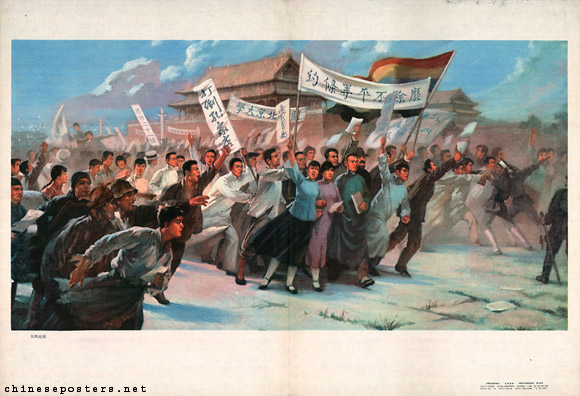
The May Fourth Movement was part cultural revolution, part social movement. On the cultural side, the students had been inspired in the preceding two decades by Western thought, creating a feeling of frustration and dissatisfaction with Chinese tradition. In the intellectual ferment that resulted from this, answers were sought for the questions why and how China had lagged behind the West. The negative influences of traditional morality, the clan system and Confucianism were seen as the main causes. China in its sorry state could only be cured by 'Two Doctors': Doctor Science and Doctor Democracy.
At the same time, intellectuals united in the New Culture Movement attempted to make Chinese culture more accessible to social groups beyond the traditional scholar-officials. To this end, they advocated a Literary Revolution, in which wenyan 文言, the ossified system of written language, was to be replaced by a system based on the vernacular, so-called baihua 白话. Hu Shi is one of the scholars identified with this movement, whereas Lu Xun is seen as one of the most prolific practitioners of this type of writing that came into being in the 1920s.
The social aspects of May Fourth consisted of attempts to emancipate the Chinese woman, although this was often limited to movements to bring footbinding to a halt. Nonetheless, in the cities newly liberated women, 'modeng [modern]' girls who had been educated, became a loud voice for further changes.
May Fourth is seen as a catalyst for the founding of the Chinese Communist Party. Before 1919, there was hardly any interest in what was happening in Russia. After May Fourth, Marxism was seen as a workable revolutionary ideology for a predominantly agrarian society such as China still was.
Even today, May Fourth functions as a point of reference for China. The Party may interpret the events of 1919 as being brought about by its earliest members, it may turn Lu Xun into the Marxist writer he would refuse to be, the fact remains that May Fourth truly set China on its revolutionary path. (http://chineseposters.net/themes/may-fourth-movement.php)
Legend of Modern Beijing: Through the years’ development, Beijing has become an international cosmopolis. The metropolis is governed as a direct-controlled municipality under the national government, with 16 urban and suburban districts.
Nowadays Beijing is the second largest Chinese city by urban population after Shanghai and is the nation’s political, cultural and educational center. It is home to the headquarters of most of China’s largest state-owned companies, and is a major hub for the national highway, expressway, railway and high-speed rail networks. The Beijing Capital International Airport is the second busiest in the world by passenger traffic.
In economy, Beijing is among the most developed cities in China, with tertiary industry accounting for 73.2% of its gross domestic product. Beijing has 41 Fortune Global 500 companies and is only second to Tokyo. There are also over 100 of the largest companies of China in Beijing. Finance is one of the most important industries. By the end of 2007, there were 751 financial organizations in Beijing generating revenue of 128.6 billion RMB, 11.6% of the total financial industry revenue of the entire country. That also accounts for 13.8% of Beijing's GDP, the highest percentage of any Chinese city. The Beijing central business district (CBD), centered on the Guomao area, has been identified as the city's new central business district, and is home to a variety of corporate regional headquarters, shopping precincts, and high-end housing. Beijing Financial Street, in the Fuxingmen and Fuchengmen area, is a traditional financial center. The Wangfujing and Xidan areas are major shopping districts. Zhongguancun, dubbed "China's Silicon Valley", continues to be a major center in electronics and computer-related industries, as well as pharmaceuticals-related research. Meanwhile, Yizhuang, located to the southeast of the urban area, is becoming a new center in pharmaceuticals, information technology, and materials engineering. Shijingshan, on the western outskirts of the city, is among the major industrial areas. Specially designated industrial parks include Zhongguancun Science Park, Yongle Economic Development Zone, Beijing Economic-technological Development Area, and Tianzhu Airport Industrial Zone.
Agriculture is carried on outside the urban area, with wheat and maize (corn) being the main crops. Vegetables are also grown closer to the urban area in order to supply the city.
Beijing is an important transport hub in North China with five ring roads, nine expressways, eleven National Highways, nine conventional railways, and two high-speed railways converging on the city.
Beijing serves as a large rail hub in China's railway network. Ten conventional rail lines radiate from the city to: Shanghai (Jinghu Line), Guangzhou (Jingguang Line), Kowloon (Jingjiu Line), Harbin (Jingha Line), Baotou (Jingbao Line), Qinhuangdao (Jingqin Line), Chengde (Jingcheng Line), Tongliao, Inner Mongolia (Jingtong Line), Yuanping, Shanxi (Jingyuan Line) and Shacheng, Hebei (Fengsha Line). In addition, the Datong–Qinhuangdao Railway passes through the municipality to the north of the city.
Beijing also has three high-speed rail lines: the Beijing-Tianjin Intercity Railway, which opened in 2008; the Beijing-Shanghai High-Speed Railway, which opened in 2011; and the Beijing–Guangzhou High-Speed Railway, which opened in 2012.
The city's main railway stations are the Beijing Railway Station, which opened in 1959; the Beijing West Railway Station, which opened in 1996; and the Beijing South Railway Station, which was rebuilt into the city's high-speed railway station in 2008. As of 1 July 2010, Beijing Railway Station had 173 trains arriving daily, Beijing West had 232 trains and Beijing South had 163. The Beijing North Railway Station, first built in 1909 and expanded in 2009, had 22 trains.
Beijing is home to a great number of colleges and universities, including Peking University and Tsinghua University (two of the National Key Universities). Owing to Beijing's status as the political and cultural capital of China, a larger proportion of tertiary-level institutions are concentrated here than in any other city in China (at least 70). Many international students from Japan, Korea, North America, Europe, Southeast Asia, and elsewhere come to Beijing to study every year, some through third party study abroad providers such as IES Abroad and others as part of an exchange program with their home universities. The schools are administered by China's Ministry of Education.
1) Beijing Community Center
2) Tiananmen Square
天安门广场
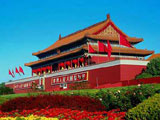
The Tiananmen Square on the north to south axis is at the center of Beijing city. It's the largest square in the world, encompassing an area of 14 hectares, and measuring 865 meters north to south, and 500 and 370 meters east to west on the northern and southern ends respectively.
The Five-Star Red Flag flutters high above the mid-point of the square's north side. Everyday, at dawn and dusk, the Guards march in unison to the foot of the flagstaff to hoist or lower the National Flag, saluted with eyes by the on-lookers.
The Monument to the People's Heroes towers over the center of the square. To its south lies Chairman Mao's Memorial Hall. The Chinese Revolutionary Museum and the Chinese History Museum stand to the east of the square, the Great Hall of the People to the west and the magnificent Heavenly Peace Gate Tower to the north. The Tower is adjoined on its left side by the Zhongshan Park and on the right side by the Working People's Palace of Culture. Opposite the tower in the far south is the Zhengyang Gate Tower. These fine and unique buildings arranged in perfect harmony add greater beauty and grandeur to the Tiananmen Square.
The Tiananmen Square is the people's square, where grand state ceremonies are held on important occasions. Also the location of historical May 5th movement(1988), and the Chairman Mao declare the founding of People’s Republic of China at Oct 1st. 1949. (http://english.cri.cn/739/2003-9-3/65@39992.htm)
3) Chairman Mao Zedong Memorial Hall
毛主席纪念堂
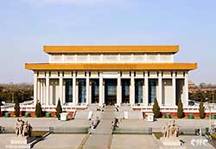
The chairman Mao Zedong Memorial Hall stands on the former sits of Zhonghuamen Gate at the southern end of Tian'anmen Square between the Monument to the People's Heroes and Zhengyangmen Gate.
Red Sichuan granite at its base and trees around the hall is designed on principles of symmetry and "centrality." Sculptures north and south supplement the artistic rendering of national struggle presented on the Monument to the People's Heroes.
The first floor is open to the public. Behind the white marble status of Chairman Mao is an immense tapestry of China's mountains and rivers.
In the Hall of Mourning, the heart of the mausoleum, lies Mao (1893-1976) in his usual gray suit, draped with the red flag of the Communist Party, in a crystal casket. The rare Phoebe nanmu wood of the doors and walls was carted north from a peak on Hainan Island under the supervision of Zhou Enlai.
Mao's poem Reply to Comrade Gao Moruo in his own hand covers the white marble face of the last hall to the south.
Out the back is a small open area, formerly known as Chessboard Street, which served as a busy hub of commerce in the Ming Dynasty. The Qianmen area, one of the Beijing's busiest commercial districts, lies beyond. (http://www.china.org.cn/english/features/beijing/30794.htm)
4) National Museum (“The Road of Rejuvenation” Exhibition)
中国国家博物馆 “复兴之路”展览
http://en.chnmuseum.cn
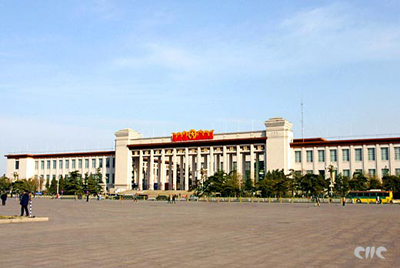
The National Museum of China (NMC) is located at the east side of Tiananmen Square, opposite the Great Hall of the People. It was founded in February 2003, based on the merging of two previous museums, namely the National Museum of Chinese History and the National Museum of Chinese Revolution. NMC, an integrated national museum under the Ministry of Culture of China, draws equally from both history and art and is dedicated to its collections, exhibitions, research, archeology, public education and cultural communication. Its basic functions are collections of cultural relics and artworks, exhibitions, public education, history and art research and cultural communication.
The predecessor of the Museum of Chinese History was the Preparatory Office of the Museum of Chinese History, founded on July 9, 1912. Upon the founding of the People's Republic of China on Oct 1st , 1949, the museum was renamed the Beijing Museum of History, only to be renamed once again as the National Museum of Chinese History in 1959. The predecessor of the Museum of Chinese Revolution was the Preparatory Office of the National Revolution Museum, which was founded in March, 1950 and was given its current name ten years later. In August 1959, with the completion of a new building on the east side of Tiananmen Square, and this housed both museums; it was acclaimed as one of the Ten Great Constructions built to celebrate the tenth anniversary of the People’s Republic of China. On Oct 1st of that same year, the two museums opened to the public.
We hold leading within China, first-class externally as our main objective, people foremost as a principle of development, honest to reality, close to life, friendly to the people as a value, and talent, collection, academics and services as the key points in running the museum. It is of great importance to preserve, inherit, display, and develop the magnificent Chinese culture. Meanwhile, as the most important cultural and art institution in China, NMC not only displays China’s outstanding civilization achievements, but also those of other parts of the world.
To support the public cultural service system and satisfy the learning needs of the community, we strive to promote the historical and cultural knowledge of the general public, in particular young people, while working to nurture civilization and facilitate life-long learning in the cultural sphere and in the classroom.
NMC plays an important role in displaying Chinese culture, cultivating national spirit; as such it is a world leader amongst museums in developing the field of cultural relics.
From March, 2007 to December, 2010, NMC carried out a project to expand the museum so that it now covers 192,000 square meters. Today NMC is the largest museum in the world, with first class facilities and capabilities. With more than forty halls, we have exhibitions of Ancient China and The Road to Rejuvenation on regular display and more than a dozen categories of display related to special exhibitions and international exchange exhibitions. Not only has the museum amassed five thousand years of Chinese art and cultural heritage, the museum itself attests to the long road to revival and provides high-quality exhibitions which reflect the fruits of this world civilization.( http://en.chnmuseum.cn/english/tabid/497/Default.aspx)
“The Road of Rejuvenation” Exhibition
“复兴之路”展览
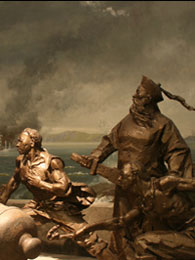
The Chinese nation, a country of diligence, courage, wisdom, and peace, has made indelible contributions to the progress of human civilization. National prosperity has been the object of unremitting pursuit for many generations.
The Road of Rejuvenation is one of the museum’s permanent exhibitions that reflects the Opium War of 1840 onward, the consequent downfall into an abyss of semi-imperial and semi-feudal society, the protests of people of all social strata who had suffered, and the many attempts at national rejuvenation - particularly the Communist Party of China’s fight for the liberation and independence of people of every ethnicity. The exhibition demonstrates the glorious but long course of achieving national happiness and prosperity and fully reveals how the people chose Marxism, the Communist Party of China, socialism, and the reform and opening-up policy. It attests to the Chinese priority of holding high the unswerving banner of socialism with Chinese characteristics, and of remaining firmly committed to the Chinese socialist road and theory.
Today, Chinese civilization already stands tall in the East. With the bright prospects of the Great Revival already before us, the dreams and pursuits of Chinese sons and daughters will surely be achieved. (http://en.chnmuseum.cn/english/tabid/520/Default.aspx?ExhibitionLanguageID=83)
Established in 1925, the Palace Museum was installed in the imperial palace of two consecutive dynasties - the Ming (1368-1644) and the Qing (1644-1911). It is one of the most prestigious museums in China and the world at large.
The Forbidden City was the Chinese imperial palace from the Ming dynasty to the end of the Qing dynasty—the years 1420 to 1912. It is located in the centre of Beijing, China, and now houses the Palace Museum. It served as the home of emperors and their households as well as the ceremonial and political centre of Chinese government for almost 500 years.
Constructed from 1406 to 1420, the complex consists of 980 buildings and covers 72 ha (over 180 acres) The palace complex exemplifies traditional Chinese palatial architecture, and has influenced cultural and architectural developments in East Asia and elsewhere. The Forbidden City was declared a World Heritage Site in 1987,[4] and is listed by UNESCO as the largest collection of preserved ancient wooden structures in the world.
Since 1925, the Forbidden City has been under the charge of the Palace Museum, whose extensive collection of artwork and artefacts were built upon the imperial collections of the Ming and Qing dynasties. Part of the museum's former collection is now located in the National Palace Museum in Taipei. Both museums descend from the same institution, but were split after the Chinese Civil War. With over 14.6 million annual visitors, the Palace Museum is the most visited Museum in the world.( http://en.dpm.org.cn/about/ https://en.wikipedia.org/wiki/Forbidden_City)
6) NGO Meetings
7) Left-wing Reporters/Intellectual eeting
8) Cultural Performance
9) Meeting (Expatriates in China)
The Great Wall of China is a series of fortifications made of stone, brick, tamped earth, wood, and other materials, generally built along an east-to-west line across the historical northern borders of China to protect the Chinese states and empires against the raids and invasions of the various nomadic groups of the Eurasian Steppe. Several walls were being built as early as the 7th century BCE; these, later joined together and made bigger and stronger, are now collectively referred to as the Great Wall. Especially famous is the wall built 220–206 BCE by Qin Shi Huang, the first Emperor of China. Little of that wall remains. Since then, the Great Wall has on and off been rebuilt, maintained, and enhanced; the majority of the existing wall is from the Ming Dynasty (1368–1644).
Other purposes of the Great Wall have included border controls, allowing the imposition of duties on goods transported along the Silk Road, regulation or encouragement of trade and the control of immigration and emigration. Furthermore, the defensive characteristics of the Great Wall were enhanced by the construction of watch towers, troop barracks, garrison stations, signaling capabilities through the means of smoke or fire, and the fact that the path of the Great Wall also served as a transportation corridor.
The Great Wall stretches from Dandong in the east to Lop Lake in the west, along an arc that roughly delineates the southern edge of Inner Mongolia. A comprehensive archaeological survey, using advanced technologies, has concluded that the Ming walls measure 8,850 km (5,500 mi). This is made up of 6,259 km (3,889 mi) sections of actual wall, 359 km (223 mi) of trenches and 2,232 km (1,387 mi) of natural defensive barriers such as hills and rivers.[4] Another archaeological survey found that the entire wall with all of its branches measure out to be 21,196 km (13,171 mi) (https://en.wikipedia.org/wiki/Great_Wall_of_China)
Yuanmingyuan (Old Summer Palace) the most beautiful royal garden ever build in China, with hundreds of thousands treasures, was completely destroyed by western power in the second Opium War of 1860 and the Eight-Power Allied Forces attacked Beijing (The Boxer Rebellion). And most of the treasures were looted to the western countries from U.S. to Japan, includes: New York Metropolitan Museum of Arts. Yuanmingyuan was approximately built in 1707, i.e. the 46th Year of Kangxi’s reign. It was originally the garden presented by Emperor Kangxi to his fourth son Yinzhen. Emperor Kangxi inscribed the tablet of Yuanmingyuan, visited Yuanmingyuan and had dinners here for many times, which, to some extent, enhanced the reputation of Yuanmingyuan. The flouring period of Yuanmingyuan began in the 1st Year of Yongzheng’s reign. The five emperors including Yongzheng, Qianlong, Jiaqing, Daoguang and Xianfeng stayed and governed in Yuanmingyuan for almost 140 years. Thus, Yuanmingyuan became the second political center (the first political center being the Forbidden City), which was called the royal garden…. ( http://www.yuanmingyuanpark.cn/ymyen/THYY/TFPY/201306/t20130603_616810.html)
From October 1856 to October 1860, Britain and France jointly started the Second Opium War for aggression against China, for the purpose to despoil more colonial privileges. Corrupted and incompetent government of the late Qing Dynasty adopted the indecisive policy for the invasion of foreign enemies, and they retreated one step after another. In May 1858, the invading Anglo-French Allied Forces, supported by Russian and the United States, attacked and occupied Dagu, which was near Tianjin. The government of Qing Dynasty was forced to sign the Treaty of Tientsin, which humiliated the country and forfeited its sovereignty, with Britain, France, Russian and the United States. In July of the 10th Year of Emperor Xianfeng’s reign (1860), the invading Anglo-French Allied Forceswith more than 10,000 people rushed outside of Dagu Port, with the excuse to escort the envoy to change the treaty, and the war started again. The government of Qing Dynasty was indecisive between combat and defence. The invading army landed from Beitang without combat. Soon, the north fort barbette of Dagu Port fell into enemy's hands. Emperor Xianfeng ordered the withdrawal from a defended position of seaport and negation of peace. The invading army threatened Tongzhou. On September 18, Tongzhou Negotiation failed. On September 21, the decisive battle of Bali Bridgebegan; the army of Qing Dynasty firstly inflicted heavy losses on the invading army and then become defeated. On the morning of September 22, Emperor Xianfeng escaped from Yuanmingyuan to Chengde. On October 6, Anglo-French Allied Forces invaded the northwest suburb of Beijing. The remnants of defeated troops of Qing Dynasty led by Sengge Rinchen escaped without fighting. The invading army went straight to Yuanmingyuan. On October 7, the invading Anglo-French Allied Forces began to loot Yuanmingyuan and sack hundreds of millions cultural relics and treasures. They destroyed the things that they could not take away. When the government of Qing Dynasty yielded to agree to accept the peace negotiation terms, Elgin and Grant the heads of the invading army of Britain, in order to force the long-term yield of the government of Qing Dynasty, made the excuse that their captured personnel were maltreated in Yuanmingyuan, and made an order to burn down Yuanmingyuan. On October 18 and 19, more than 3000 British cavalrymen set on fire in every place of Yuanmingyuan. The fire lasted for three days and three nights. A famous garden of the generation was unfortunately destroyed.
In 1860, after the fire of Yuanmingyuan, some remnant architectures were still in the three gardens of Yuanmingyuan. It was still the royal forbidden garden, and kept the officials including the steward. During Emperor Tongzhi’s reign, the emperor attempted to rebuild parts of Yuanmingyuan. Due to insufficient fund, the plan was aborted. In 1900, when the Eight-Power Allied Forces attacked Beijing (The Boxer Rebellion), Empress Dowager Cixi and Emperor Guangxu hurried to escape to the west. The invading army set on fire, killed people, captured people and sacked things, and made the inside and outside of Beijing in chaos. During the chaos caused by war, bandits, army ruffians and eunuchs in charge of Yuanmingyuan went on the scamp, pushed over remnant architectures, dismantled and moved timbers, bricks and tiles for several months. Thus, the remnant architectures of Yuanmingyuan and hundreds of gardening architectures which were repaired and rebuilt in Emperor Tongzhi’s reign and Emperor Guangxu’s reign were thoroughly destroyed. Old trees and famous wood species were chopped down and disappeared. Until that time, ruins and waste grass were in the three gardens of Yuanmingyuan, expect the Palace Gate of Yichunyuan, the arc of Fuyuan Gate and a couple of houses in ZhengjueTemple. At the end of Qing Dynasty, Yuanmingyuan was still the forbidden garden. The paddy fields and reed ponds were rented to households in Yuanmingyuan to plant. The royal household charged rent each year. After the emperor of Qing Dynasty was abdicated, Yuanmingyuan was the private property of the royal household. However, the remains of bricks and stones in Yuanmingyuan were grabbed and kept, or destroyed in an organized manner. In the second half year of 1928, after Beiping SpecialCity’s taking over of Yuanmingyuan site, the remains of bricks and stones in Yuanmingyuan were sold or removed for other use with approval. Thus, after the looting and fire disaster of the intruder, and disasters of woods, stones and lands afterward, the famous garden of a generation finally descended to ruins. (http://www.yuanmingyuanpark.cn/ymyen/THYY/TDY/201306/t20130603_616811.html)
It is geographically situated in the northwestern part of Beijing city, in a band between the northwestern Third Ring Road and the northwestern Fourth Ring Road. Zhongguancun is very well known in China, and is often referred to as "China's Silicon Valley". (https://en.wikipedia.org/wiki/Zhongguancun)
The Zhongguancun National Demonstration Zone dates back to the "Zhongguancun Electronics Street" in the early 1980s. In May 1988, the State Council approved the establishment of the Beijing New Technology Industrial Development Trial Zone (predecessor of the Zhongguancun Science and Technology Park). Thus Zhongguancun became the first high-tech park in China.
On March 13, 2009, the State Council approved the construction of the Zhongguancun National Demonstration Zone, and made the plan to build Zhongguancun a S&T innovation center with a global influence,. Later the Development Plan Outline for Zhongguancun National Demonstration Zone (2011-2020), was launched by the State Council on Jan 26, 2011, marking a new starting point for Zhongguancun's development.
During the past two decades, Zhongguancun has gathered nearly 20,000 high and new-tech enterprises, represented by Lenovo and Baidu, and has formed a high and new-tech industrial cluster featuring electronic information, biomedicine, energy and environmental protection, new materials, advanced manufacturing, aerospace, R&D and service.
Zhongguancun is the most intensive scientific, education and talent resource base in China. It boasts almost 40 colleges and universities like Peking University and Tsinghua University, more than 200 national (municipal) scientific institutions such as the Chinese Academy of Social Sciences and the Chinese Academy of Engineering, 67 state-level laboratories, 27 national engineering research centers, 28 national engineering and technological research centers, 24 university S&T parks and 29 overseas student pioneer parks.
Zhongguancun is one of the "innovation and entrepreneurial base for overseas talents" conferred by the Central Personnel Work Coordination Group. There are more than 5,000 enterprises with at least 15,000 overseas returnees. The entrepreneur representatives include Lenovo president Liu Chuanzhi and Li Yanhong, president of Baidu, and Kai-Fu Lee, Google Greater China's former CEO and the president of Innovation Works.
Zhongguancun's venture capital cases and investment amount every year account for about a third of the country's total. Today, the number of listed companies in the zone adds up to 189, comprising of 113 domestic and 76 overseas companies. As many as 38 enterprises have been listed on the Chinese Growth Enterprise Market. Zhongguancun plans to establish a national S&T financial innovation center that involves government and social funds, industrial and financial capital, and direct and indirect finances.
To meet the national strategic requirements and Beijing's needs for socioeconomic development, Zhongguancun has obtained a large number of key technical breakthroughs, innovation results and critical S&T innovations, such as the super computer, human vaccines against SARS and bird flu. Zhongguancun also provided technical support for the implementation of major state construction projects, including aerospace engineering, the Three Gorges Project, and the Qinghai-Tibet Highway construction.
Zhongguancun enterprises have formulated 86 important international standards like TD-SCDMA, McWill and IGRS, and 798 national, local and industrial standards. Its technology transaction values exceed a third of the country's total, including 80 percent of project products and services exported outside Beijing.
In 2010, the gross income of enterprises in Zhongguancun achieved 1.59 trillion yuan, an increase of 22.6 percent, taking up about one seventh of all high and new-tech zones in China and contributing 23.5 percent to Beijing's economic growth.
Currently, Zhongguancun is home to 10 parks, namely, Haidian, Fengtai, Changping, Electronics City, Yizhuang, Desheng, Yonghe, Shijingshan and Tongzhou Parks as well as the Daxing Biomedicine Industrial Base.
During the 12th Five-Year Plan period, Zhongguancun will further improve its Science and Future S&T Cities, promote the development of the northern R&D service and high-tech industrial belt, which are located in North Haidian, South Changping, as well as the southern high-tech manufacturing and emerging industrial belt consisting of the Beijing Economic-Technological Development Area and partial areas of Daxing, Tongzhou and Fangshan districts.
(http://en.zhongguancun.gov.cn/2013-12/04/content_17148863.htm)
13) Military Museum of the Chinese People’s Revolution
中国人民革命军事博物馆
http://eng.jb.mil.cn/
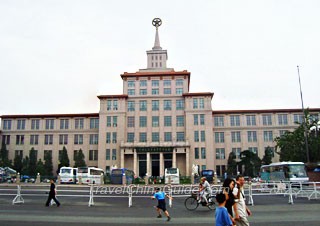
Situated not far west of Tiananmen Square along Chang'an Avenue, it was constructed in 1959. It was constructed to celebrate the tenth anniversary for the founding of the People's Republic of China. It is the only military museum in China, occupying more than 93,700 square meters (23 acres), and half it is dedicated to the history and culture of Chinese Army. The main building is 94.7 meters (about 310 feet) tall and divided into 7 floors, and the building has two wings of 4 stories. On the top of the building shines the gild Badge of Chinese Army. The name for this one was given by Chairman Mao, and now the plaque with the name hangs above the front gate. The bronze gate is 4.9 meters (16 feet) tall and made of cartridges. On the two sides of the gate stand white marble statues of heroic aeroamphibious soldiers and possemen.
In it, exhibits are categorized in 22 halls and 2 squares. There are 9 basic halls: Hall of the Agrarian Revolutionary War, Hall of the Sino-Japan War, Hall of China Civil War, Hall of Korean War, Hall of Ancient Wars, Hall of Modern Wars, Hall of China's National Defense and Army Building Achievements, Hall of Weapons, Hall of Friendly Exchanges between China's PLA and Foreign Militaries, and The Hall of a Selection of Artworks, all of which are arranged in chronological order.
On the first floor, there are two main halls. The Hall of the Agrarian Revolutionary War is on the left side, and focuses on the history of revolutionary wars against feudal land system from August, 1927 to July, 1937. The Hall of Weapons is in the center, and displays six categories of weapons: small arms, artilleries, missiles and so on. They have all either been used by Chinese Army in wars or were invented by Chinese scientists.
On the second floor, two major permanent halls are both on the left side. The Hall of the Sino-Japan War is the first, portraying the history of Chinese people's life during the war time from July, 1937 to August, 1945. After turning around, one can find the Hall of China Civil War, documenting the historical facts about the confrontations between the Communist Party and Kuomintang from August, 1945 to October, 1949; this period is presented in 5 parts. Not only the history of these wars, but also the but culture, is vividly displayed. The Hall of Selected Military Artworks is located on the second floor in the central part. In the hall, famous and impressive military arts are there to admire and enjoy.
On the third floor, the Hall of Ancient Wars is on the west side. The splendid Chinese military culture of more than five thousand years is displayed in the line of history, which started in Qin Dynasty (221-206BC) to Qing Dynasty (1644 ~1911). Meanwhile, you can also enjoy sculptures, waxworks, and models which record the wars and inventions in the history. The Hall of National Defense and Army Building Achievements of People's Republic of China is on the east side and mainly presents the growth and glory in national defense and army building of the country.
On the left-hand side of fourth floor lies the Hall of the Modern Wars which is from 1840 to 1919. In the central hall of the fourth floor is the Hall of Friendly Exchanges between China's PLA and Foreign Militaries with the theme of "Peace and Friendship". It mainly displays 500 examples of gifts received by the Chinese Army in the past. You can enjoy the history and culture of different nations can be appreciated through these gifts. The Hall of the Korean War is on the east side, covering 1300 square meters (1544 square yards) and presenting the history of wars on the land of Korea from 1951 to 1953. About 300 pictures and 900 cultural relics, describing heroes and famous marshals, are shown there, such as Peng Dehuai.
Another important and interesting exhibition is the Resist America A id Korea War (Korean War) of 1950-1953, and the crashed four U2 CIA spy planes in China by Chinese missiles during 1960s.
The Lugouqiao (Marco-Polo Bridge) an important historical place for WWII,on July 7, 1937, the first shot of the War of Resistance Against Japan rang out beside the Lugou Bridge. When Japanese troop crossing the bridge occupied nearby Wanping Fortress, then Beijing city few days later. The beginning of Chinese resistance against Japanese invasion after Jiang Jieshi refused to fight Japan, but spend all efforts to war with Chinese communist Red Army troops, following Japan invaded and occupied Chinese North-Eastern area at September 18th, 1931 (The Manchuria Crisis).
The Bridge is located 15 kilometers southwest of Beijing proper. Known also as the Guangli Bridge, it spans the banks of the Yongding River. According to historical records, the "Lugou River is also called the Heishui (Black Water) River." In the local dialect in ancient times, lu (reed) meant black; thus the Heishui River became known as the Lugou River, and the bridge was accordingly given the same name.
Historical records also inform us that the Lugou River was "violent and flowed extraordinarily rapidly." With the post-1949 construction of the Guanting Reservoir upstream from the bridge, a multitude of trees were planted on the river banks and the formerly disposition was also tamed, no longer presenting he constant danger of floods. The Lugou River was also known as the Wuding (Lacking Stability) River, and despite the fact that Emperor Kangxi had the auspicious name Yongding (Eternal Stability) bestowed upon it, it was only after the founding of the People's Republic that eh river truly became "eternally stable." After seven centuries, however, the river water remains as swift as ever. Owing, however, tot eh extraordinarily durable construction of the bridge's foundation; the endless battering of the torrential current has left no mark on it.
The Lugou Bridge is situated at a strategic point on the one overland route to the capital from the south. Bridge construction was begun in 1189 and completed four years later. The bridge is 235 meters long of white marble. It has 11 arches and as many broad piers. At the extremes of the bridge there are two stone stelae, one recording the history of the renovation work carried out in the reign of Emperor Kangxi (1662-1722), and the other bearing the inscription "The Moon over the Lugou Bridge at Dawn" in the handwriting of Emperor Qianlong.
Lining the bridge are two rows of carved white marble balustrades topped by posts carved with figures of lions. The people of Beijing have a saying to the effect that "the lions of the Lugou Bridge are too numerous to count," which is explained by the fact that the lions are carved in a great variety of aspects and distributed unequally among the 280 white marble posts. A pair of vividly carved reclining stone elephants and a number of other animal figures guards each end of the bridge.
On July 7, 1937, the first shot of the War of Resistance Against Japan rang out beside the Lugou Bridge. But now all signs of the war have long since disappeared. As the sun sets, the furnaces of nearby Shijingshna Steel Works cast a red glow across the sky, lighting up the bridge in fiery splendor.
15) Wanping Fortress
宛平城
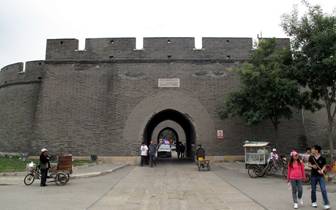
Wanping Fortress, also known as Wanping Castle (Chinese: 宛平城; pinyin: Wǎnpíng Chéng), is a Ming Dynasty fortress or "walled city" in Beijing. It was erected in 1638–1640, with the purpose of defending Beijing against Li Zicheng and the peasant uprising. On July 7, 1937, the first shot of the War of Resistance Against Japan rang out beside the Lugou Bridge enter Wanping Fortress. The Museum of the War of Chinese People's Resistance Against Japanese Aggression, surrounded by a plaza and park with numerous sculptures, occupies a large portion of the space inside the fortress' walls. (https://en.wikipedia.org/wiki/Wanping_Fortress)
16) Museum of the War of Chinese People's Resistance Against Japanese Aggression
中国人民抗日战争博物馆
http://www.1937china.com
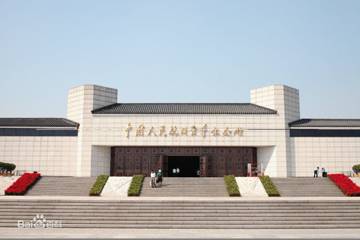
Located inside Wanping Fortress near Lugou Bridge (Macro Polo Bridge) where the war against Japanese aggression broke out, the Museum of the War of the Chinese People’s Resistance Against Japanese Aggression is a large-scale specialized museum introducing the history of the Chinese people’s resistance against Japanese aggression. In 1987, 1997, 2005 and 2010, the state and Beijing Municipality grandly held activities to commemorate the outbreak and victory of the war against the Japanese aggression in the museum several times.
After it was established in 1987, the museum has been developed in several phases. In front of the museum is the Square Against the Japanese Aggression with an area of 8,600 square meters, where a watchful lion sculpture stands in the center, representing the arousal of the Chinese nation. On each side of the central axis of the square lie seven pieces of lawn, representing the Incident of July 7 and the 14-year war of the Chinese nation against Japanese aggression. A 14-meter high flag pole on the white marble base stands high in the north part of the square. With the outer wall made of creamy marble and the bronze gate with patters of medals of independence and liberty, the museum looks solemn and grandiose.
After three phases of changes, the museum now has a display area of more than 6,700 square meters. With the deepening of research, the exhibits are more scientifically arranged and new concepts and technologies have been introduced. In 2005, the Great Victory, a large-scale themed exhibition, was held in the museum. With historic photos and objects and assisted with measures such as landscape, oil paintings, sculptures, visual images and films, the exhibition highlighted the history of the Chinese people of various ethnic groups, including compatriots in Hong Kong and Macao and overseas Chinese jointly fighting the aggression of the Japanese imperialists based on the Kuomintang-Communist cooperation under the banner of anti-Japanese national united front initiated by the Communist Party of China, represented the backbone roles of the Communist Party of China in the war, showed the huge sacrifice and the important contribution of the Chinese nation for the victory of the world’s anti-Fascist war, and deeply disclosed the monstrous crimes the Japanese invaders had committed during their aggression against China.
One of the basic exhibits of the museum, the semi-landscape picture with the theme of the Incident of July 7 was initially initiated in China at that time. The exhibit combines a huge oil painting with objects and models. With the computer-controlled audio, light and electricity technologies, the oil painting can show the effect of rolling dark cloud, smoke of gunpowder and flames of war, giving the audience the real experience of the war in Lugou Bridge.
Besides the basic display, the museum has also held more than 60 special exhibitions such as the Evidences of Crime of the Japanese Aggression, Crime of Japanese Aggressors of Launching Chemical Warfare, Crimes of Japanese 731 Bacteriological Troop, Photo Exhibition of the Taiwan Compatriots’ Resistance Against Japanese Aggression, Exhibition of the Joint Efforts Against Japanese Aggression of China, the United States and the Soviet Union Air Force in China War Zone, and Shouting for the Anti-Aggression War --- Anti-Aggression Literatures and Arts of the Communist Party of China. These special exhibitions not only compensated and deepened the basic display, but also played important roles in further strengthening historical education.
The museum also made great efforts to collect cultural relics and research the anti-aggression history. Now, it has more than 20,000 pieces of cultural relics, including more than 100 national first-level relics, and more than 100 literary works of various kinds. In addition, many important groups such as China Society on the Studies of Anti-Japanese Aggression History, Specialty Memorial Commission of Chinese Museums Association, Beijing Foundation of Chinese Anti-Japanese Aggression History Studies and Peace Education, and Beijing Association of Chinese Anti-Japanese Aggression History Studies are affiliated to the museum. Their secretariats are all in the museum.
The Museum of the War of the Chinese People’s Resistance Against Japanese Aggression is an important window for the peoples of various countries in the world to learn about China’s anti-aggression war history. After it was put into service in 1987, it has received important politicians from more than 10 countries, including former Japanese Prime Minister Tomiichi Murayama, and more than 300,000 visitors from more than 80 countries and regions. The museum also held exhibitions with anti-aggression theme in countries such as Japan, the United States, Singapore, Russia and the Republic of Korea and regions like Taiwan, Hong Kong and Macao to strengthen exchanges and cooperation with these countries and regions.
The Museum of the War of the Chinese People’s Resistance Against Japanese Aggression is a first-class national museum and has so far received more than 16.6 million visitors from home and abroad. We look forward to your presence. (http://www.1937china.com/enweb/20120621/8536.shtml)
17) Beijing Mentougou village
门头沟
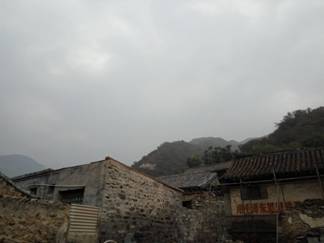
Located Beijing’s western part of the mountain area, Mentougou district and their villages has rich agricultural, cultural and revolutionary history.
We’ll stay at village motel, visit village council to understand their economy and revolutionary history. |

